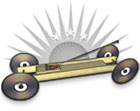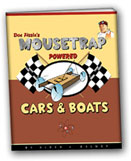Mousetrap Vehicles: Fluid Friction
Air resistance is what an object experiences as it moves through a fluid, air being a fluid. Learn all about fluid friction and how it applies to mousetrap racers.
Perhaps the second most important concept to understand when building a mousetrap powered vehicle is the concept of friction. In the perfect universe where there was no friction a mousetrap vehicle would travel forever or until it hits something. But we do not live in a perfect universe and friction is a real force that acts against the motion of all moving objects. Friction occurs anytime two surfaces slip, slide, touch, and/or move against one another. There are two basic types of friction, surface friction, and fluid friction. Friction is a force that acts against the motion of all moving objects. Energy is always needed to overcome friction and the greater the amount of friction the less efficient the system. Two of the by product of friction are heat and sound, these are normally considered lost forms of energy because it is hard to recapture energy once it has been turned into heat and sound.
Fluid Friction
Imagine you are in a pool of water, you will find that it is easy to walk around in the water at a slow speed but once you try moving fast or even try running in the water you immediately feel the resistance of the water pushing against your motion; this is the same effect that all objects will experience as they tries to push it's way through the air. The air behaves and is a fluid, not as dense as water but never the less the air pushes against the motion of all moving objects. The faster an object moves through the air the more collisions the object has with the air particles that slow it's motion. Unlike surface friction, fluid friction is speed dependant. The faster an object moves the more collisions the objects will have with the fluid particles and the greater the resistance becomes as the particles in the fluid push back. If you look at the shape of a fish they have a very aerodynamic shape in order to cut through the water with the least amount of fluid friction. The force of friction due to a fluid depends on many factors and includes how fast an object is moving, the density of the fluid, the cross section of the area exposed to the fluid, and the coefficient of drag.
Factors that effect the air resistance:
- the speed
- the shape
- the fluid density
ƒdrag = (1/2) CρAv2
formula: The force of friction [ƒ] depends on one-half the drag coefficient [C], the density of the fluid [ρ], the cross-sectional area [A], and the velocity [v] squared. The coefficient is measured in newtons, the normal force in newtons, and the coefficient is newtons over newtons.
Terminal Velocity
When an object is falling under the influence of gravity or is subject to some other constant force, and is subject to a resistance or drag force which increases with velocity, it will ultimately reach a maximum velocity where the drag force equals the driving force. This final, constant velocity of motion is called a "terminal velocity", a terminology made popular by skydivers. At this terminal velocity an object will travel at a constant velocity and the only way to increase this terminal speed is to increase the driving force and/or change the shape of the object.

terminal velocity: the shape of an object will be one factor that determines the terminal speed.
*Can't find what you're looking for? Ask Doc Fizzix »




